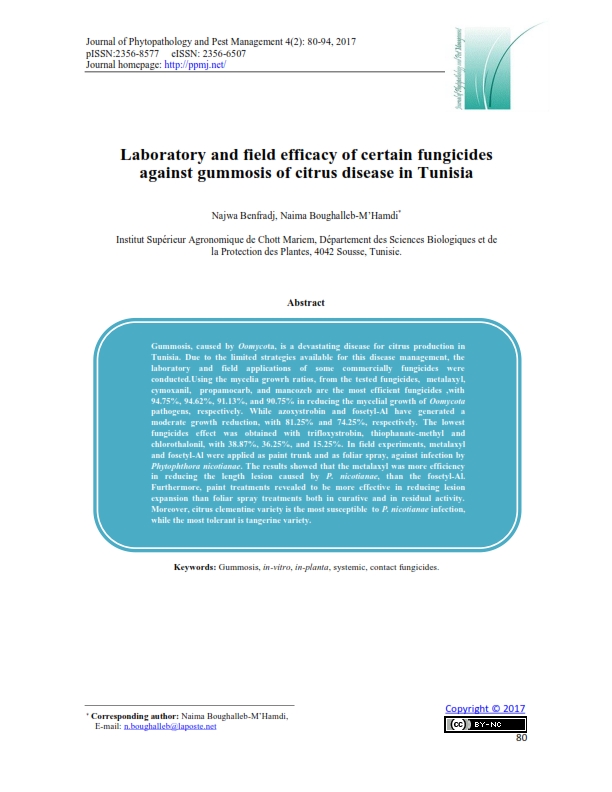Laboratory and field efficacy of certain fungicides against gummosis of citrus disease in Tunisia
Keywords:
Gummosis, in-vitro, in-planta, systemic, contact fungicides.Abstract
Gummosis, caused by Oomycota, is a devastating disease for citrus production in Tunisia. Due to the limited strategies available for this disease management, the laboratory and field applications of some commercially fungicides were conducted.Using the mycelia growrh ratios, from the tested fungicides, metalaxyl, cymoxanil, propamocarb, and mancozeb are the most efficient fungicides ,with 94.75%, 94.62%, 91.13%, and 90.75% in reducing the mycelial growth of Oomycota pathogens, respectively. While azoxystrobin and fosetyl-Al have generated a moderate growth reduction, with 81.25% and 74.25%, respectively. The lowest fungicides effect was obtained with trifloxystrobin, thiophanate-methyl and chlorothalonil, with 38.87%, 36.25%, and 15.25%. In field experiments, metalaxyl and fosetyl-Al were applied as paint trunk and as foliar spray, against infection by Phytophthora nicotianae. The results showed that the metalaxyl was more efficiency in reducing the length lesion caused by P. nicotianae, than the fosetyl-Al. Furthermore, paint treatments revealed to be more effective in reducing lesion expansion than foliar spray treatments both in curative and in residual activity. Moreover, citrus clementine variety is the most susceptible to P. nicotianae infection, while the most tolerant is tangerine variety.Â
Metrics

Published
How to Cite
Issue
Section
License
Authors who publish with Journal of Phytopathology and Disease Management agree to the following terms:
- Authors retain copyright and grant the journal right of first publication with the work simultaneously licensed under a Creative Commons Attribution License that allows others to share the work with an acknowledgement of the work's authorship and initial publication in this journal.
- Authors retain copyright and grant the journal right of first publication with the work simultaneously licensed under the Creative Commons Attribution-Non Commercial License (CC BY-NC). This allows others to share the work with an acknowledgement of the work's authorship and initial publication in this journal.
- Archives of Agricultural Sciences Journal is an Open Access Journal, and articles published are distributed under the terms of the Creative Commons Attribution-Non Commercial License (CC BY-NC). Readers may copy, distribute, and display the work for non commercial purposes with the proper citation of the original work. However, the journal retains the right to exploit subsidiary rights on behalf of the authors.
- Authors are able to enter into separate, additional contractural arrangements for the non-exclusive distribution of the journal's published version of the work (e.g. post it to an institutional repository or publish it in a book), with an acknowledgement of its initial publication in this journal.
- Authors are permitted and encouraged to post their work online (e.g., in institutional repositories or on their website) prior to and during the submission process with full disclosure to the journal, as it can lead to productive exchanges, as well as earlier and greater citation of published work. Following publication in Archives of Agricultural Sciences Journal, the author should update the repository, and include a citation and link to the published work.
Click here for more information on Licensing policy
.png)




